Train travel in Java offers one of the most scenic and practical ways to explore Indonesia’s most populous island. For foreign tourists, it’s a perfect blend of affordability, comfort, and convenience. Whether you’re traveling between major cities like Jakarta, Yogyakarta, and Surabaya, or heading off the beaten path, trains provide a stress-free way to cover long distances while taking in breathtaking views of Java’s landscapes.
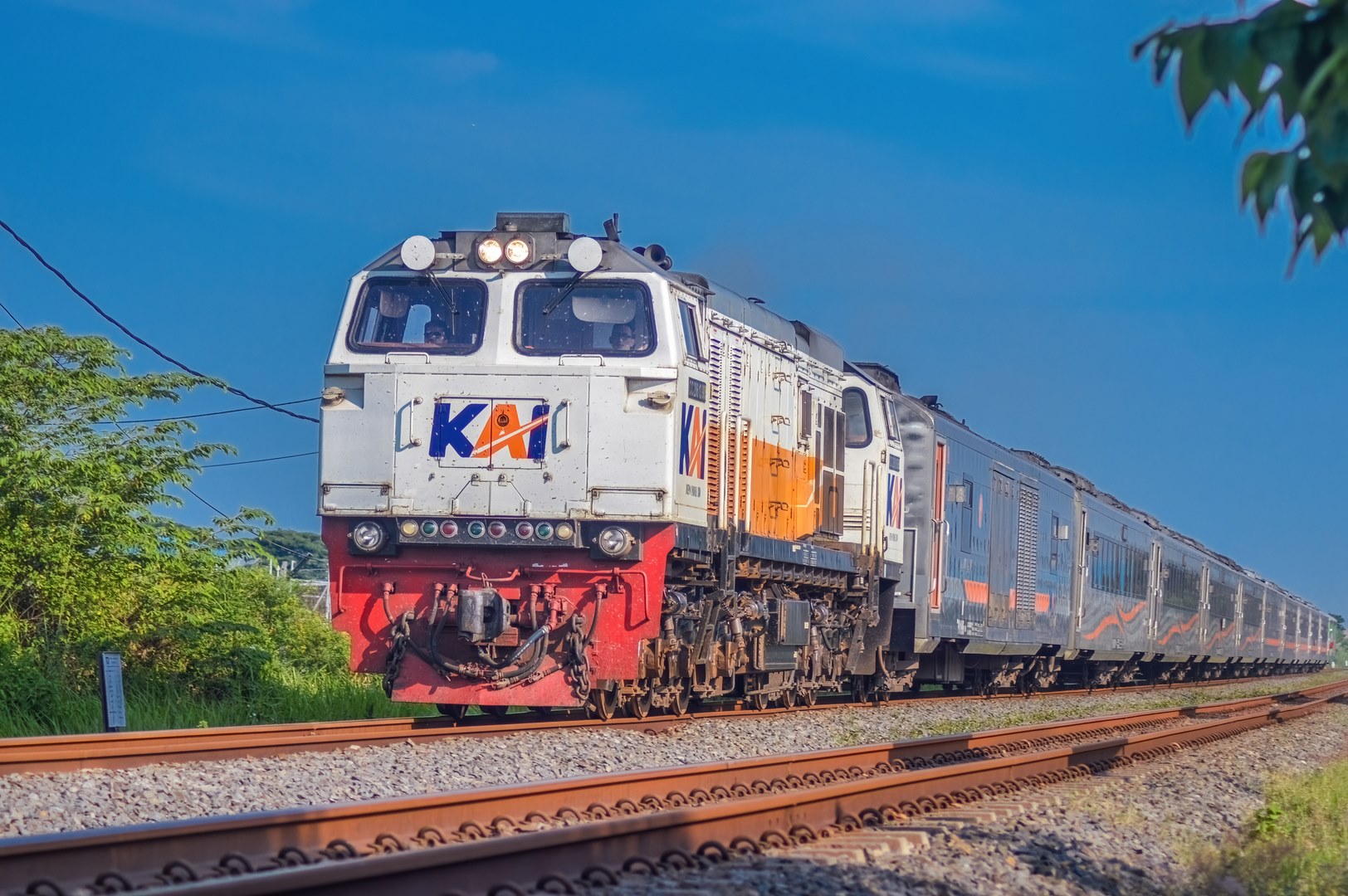
If it’s your first time navigating Indonesia’s railway system, you might have questions about how to book tickets, the different train classes, or what to expect at the stations. This guide will walk you through everything you need to know—based on my personal experiences—to ensure your train journey is smooth and enjoyable. From ticket tips to station insights and recommendations for making the most of your ride, I’ve got you covered.
Types of Trains in Indonesia
In Indonesia, trains are an essential mode of transportation, though the network is not as extensive or frequent as in Europe. Trains here are categorized based on distance, routes, and service types, and many even have unique names, such as Argo Parahyangan, Taksaka, or Gajah Wong, adding a cultural touch to the travel experience.
Intercity Trains
Intercity trains are the backbone of long-distance travel across Java. These trains connect major cities such as Jakarta, Yogyakarta, Surabaya, and Bandung. Services are divided into Economy and Executive classes.
While all train classes are equipped with air conditioning, smoke-free carriages, toilets, and a dining car, the main differences lie in the seat arrangements, the number of seats per row, and some additional amenities, especially in executive class.
Economy Class (EKO)
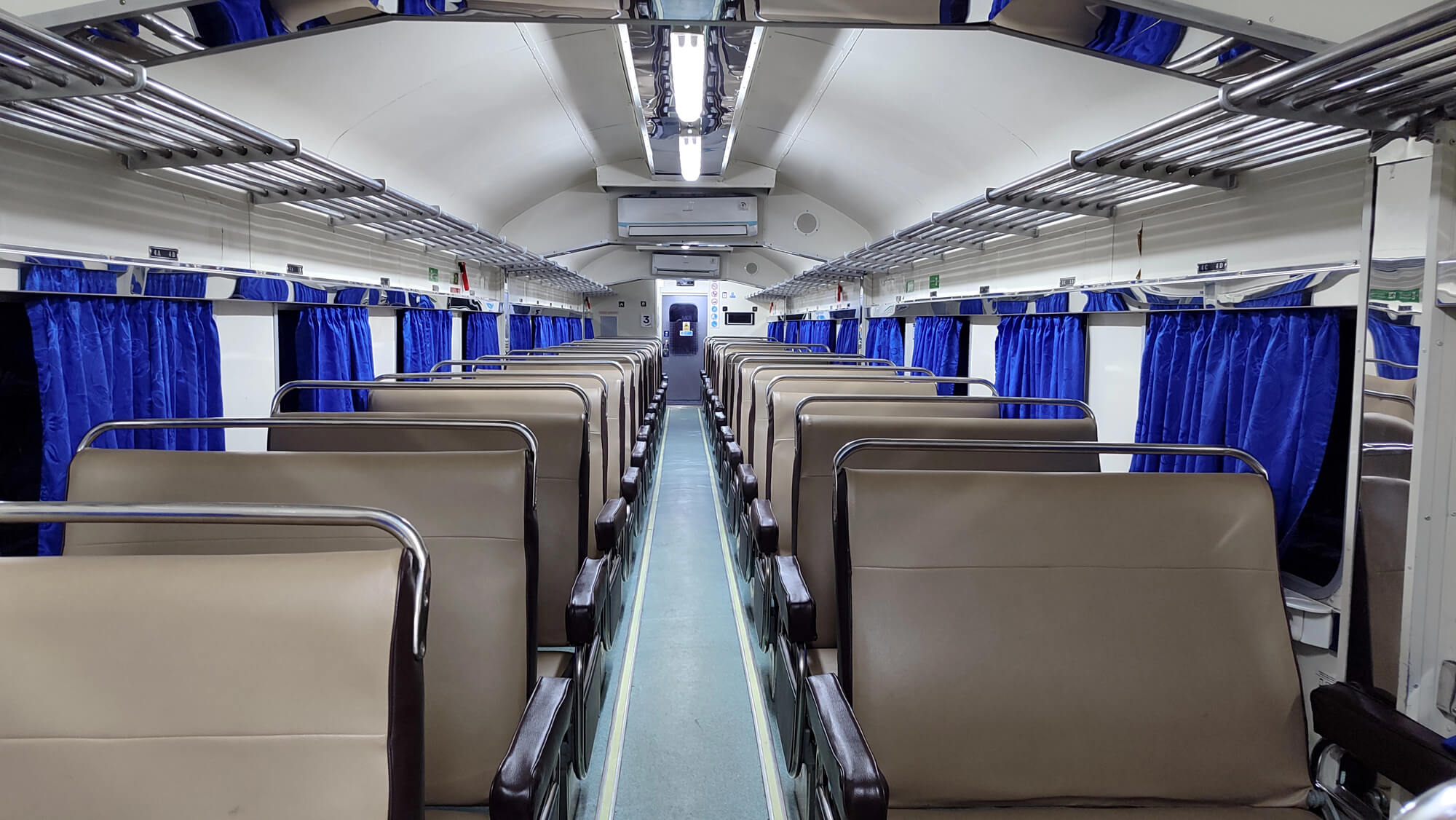
This is the most affordable option, with air-conditioned carriages and face-to-face seating arrangements (2 or 3 seats per row). You’ll share the space with 4 to 6 passengers, and the legroom might be a bit tight.
Facilities:
- A small table under the window for drinks
- Two power outlets under the seats
- Toilets at the front and rear of each carriage
There’s also a Premium Economy class, which offers more comfortable seats and is a replacement for the now-discontinued Business Class.
In general, economy class is popular among locals and tends to fill up much faster than executive carriages, which offer more comfort, especially if you’re over 180 cm tall or traveling with a large backpack or suitcase.
Executive Class
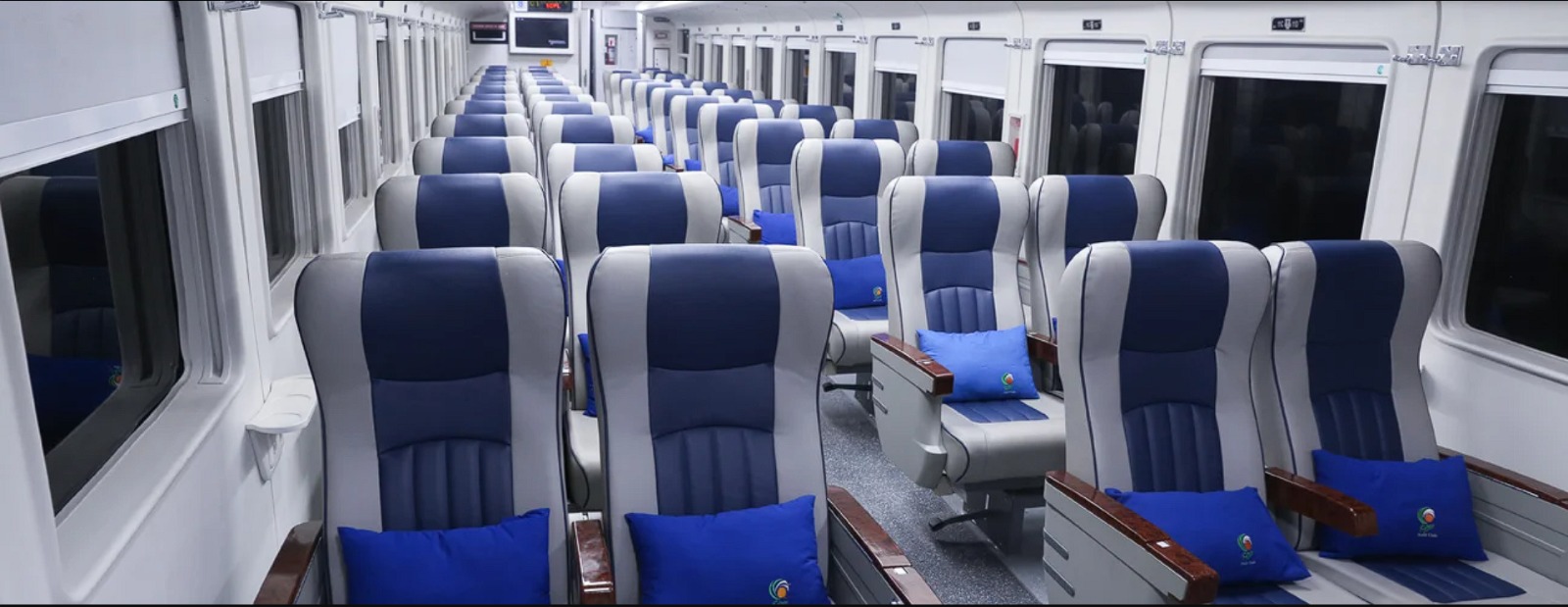
This is the most popular choice among foreign travelers. Executive class offers more comfortable seating, much more legroom and superior service.
Facilities:
- Comfortable armchairs with ample legroom
- Reclining seats with adjustable angles
- Complimentary pillows and blankets
- Larger luggage compartments
- Power outlets and drink holders
Explore Indonesia by train, and for a premium experience, discover Luxury Trains in Indonesia: Ultimate Comfort for Travelers.
Commuter Lines
Commuter trains (KRL) serve shorter distances, such as Jakarta to Bogor or Yogyakarta to Solo, and are a practical choice for daily commutes or short trips. They are affordable and reliable but can get crowded, particularly during rush hours.
Urban Trains (MRT/LRT)
Urban train systems like the MRT and LRT operate only in Jakarta and its surrounding areas. These modern trains are convenient for navigating the capital’s dense traffic, though the routes are currently limited.
High-Speed Train (Whoosh)
Indonesia recently introduced its first high-speed train, Whoosh, connecting Jakarta and Bandung in just 40 minutes. It’s a game-changer for those traveling between these two cities, offering speed and modern amenities.
Feel the thrill of high-speed travel. Explore everything you need to know in Whoosh: Complete Guide to Indonesia’s High-Speed Train.
Airport Trains
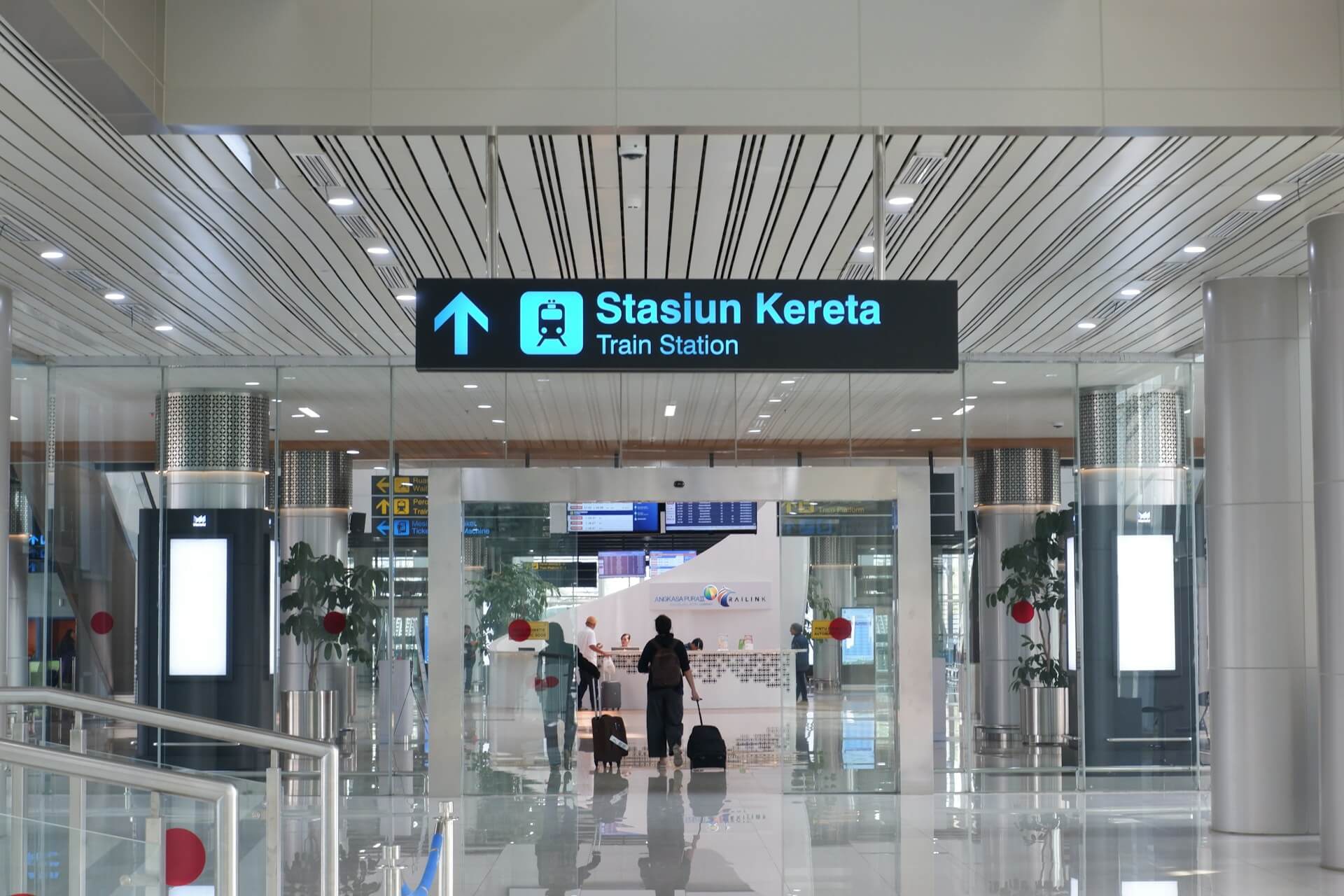
For travelers arriving by plane, Airport Trains provide seamless connections between airports and city stations. Key routes include:
- Soekarno-Hatta Airport (Jakarta) to Jakarta city center.
- Yogyakarta International Airport (YIA) to Yogyakarta city.
- Kualanamu Airport (Medan) to Medan city center.
How to Purchase Train Tickets
Booking train tickets in Indonesia can be straightforward, but for foreign travelers, there are a few things to keep in mind to make the process easier.
Don’t Use the Official KAI Access App and Website
Indonesia’s state-owned railway company, KAI (Kereta Api Indonesia), offers an official app called KAI Access and a website for booking train tickets. While these platforms provide the most direct and often cheapest way to buy tickets, they come with one major drawback: they don’t accept international credit or debit cards. For foreign travelers, this makes them virtually unusable.
Recommended Sites for Foreign Travelers
For foreign travelers, the easiest way to book train tickets in Indonesia is through third-party platforms like Traveloka or tiket.com. Both websites and apps are user-friendly, accept international cards, and allow you to compare ticket prices, train classes, and schedules effortlessly.
However, there’s one key difference: tickets for the Whoosh high-speed train are currently only available on tiket.com and not on Traveloka. So if you’re planning to try Indonesia’s high-speed rail, be sure to use Tiket.com for your booking.
Understand Seat Codes to Get the Best Price
When booking train tickets online in Indonesia, you might come across seat codes like CA, CB, CC, H, and others. These codes indicate the seat arrangement within the carriage, not availability, and they can affect the ticket price.
- Middle Seats: Seats located in the middle of the carriage are typically more expensive. They offer a smoother ride with less shaking and are further away from high-traffic areas like toilets.
- End Seats: Seats near the ends of the carriage are usually cheaper. However, they tend to experience more movement, are closer to the toilets, and are often colder due to stronger air conditioning.
The good news? Most booking platforms, like Traveloka and tiket.com, allow you to select your seat when purchasing a ticket. This means you can choose the cheapest fare while still securing a comfortable seat in the middle of the carriage—getting the best value for your money.
Planning to explore Java Island? Read our guide: Java: The Ultimate Travel Guide with Insider Tips.
At the Station
If you prefer to buy tickets in person or encounter issues with online payments, you can purchase tickets directly at train stations. While this works, keep in mind that popular routes and times often sell out quickly, especially on weekends and holidays. Since train frequencies in Indonesia are relatively low compared to some other countries, this option isn’t ideal if you’re working with a strict schedule. Booking in advance online remains the safest choice for a smooth journey.
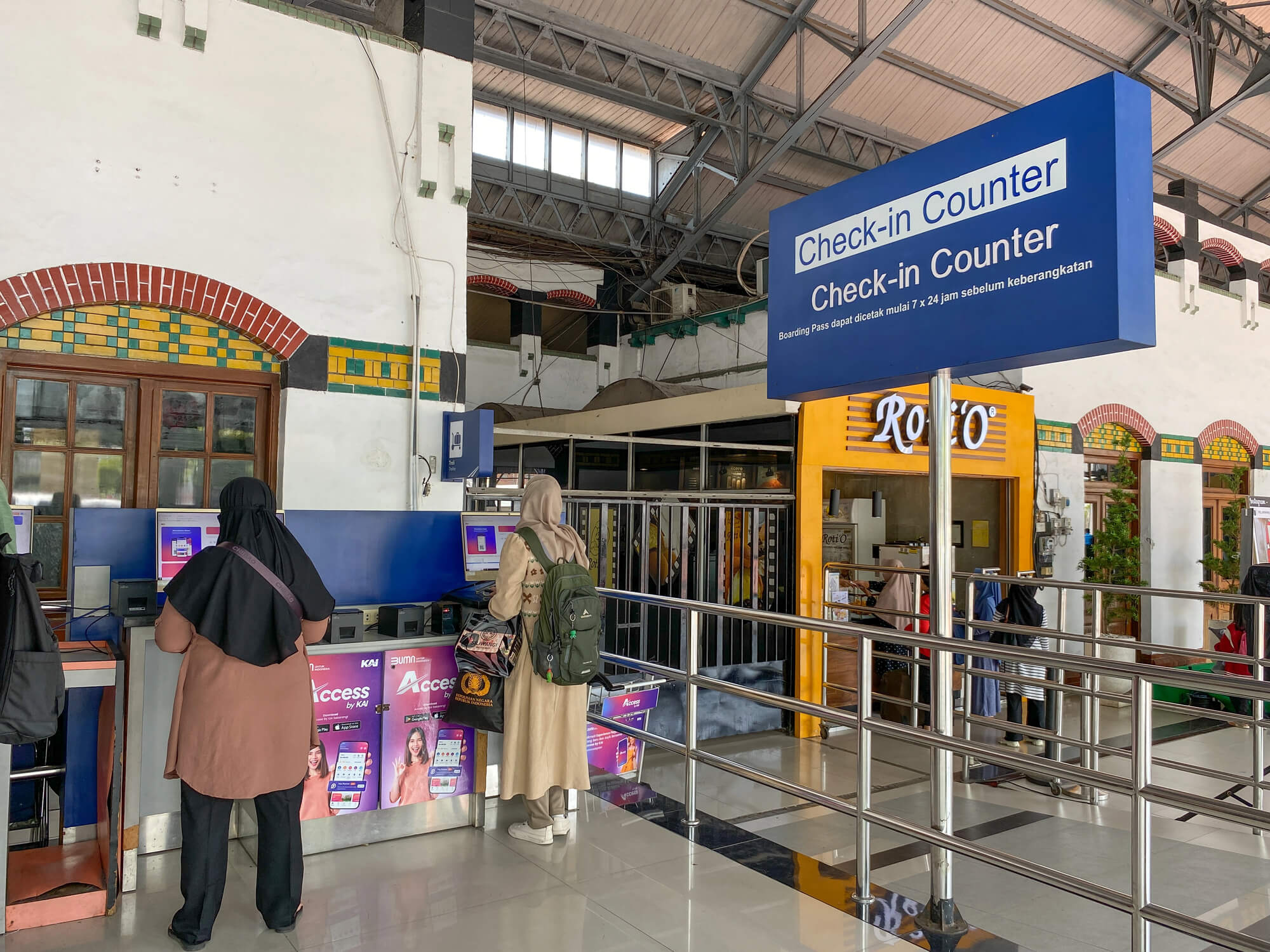
Important Tips for Booking
- Book Early: Tickets for long-distance trains can be booked up to 30 days in advance (45 days for Idul Fitri holidays), and they tend to sell out quickly for popular routes and during holiday periods.
- Provide ID: You’ll need a passport number or valid ID when purchasing tickets. Ensure you have this information handy, as it’s required to confirm your booking.
- Print Your Ticket: For most routes, an e-ticket from Traveloka or Tiket.com is sufficient, but at some stations, you may be required to print a physical ticket. Printing kiosks are usually available at the station.
Main Long-Distance Train Stations in Java
Not all train stations in Indonesia offer departures for long-distance routes, and many cities have multiple stations. Knowing which station serves your route is essential to avoid confusion.
Jakarta
The capital city has several train stations, but only two handle long-distance intercity trains:
- Gambir Station: Reserved for Executive Class and Premium Economy Class trains.
- Pasar Senen Station: Serves all classes and offers a wide range of route options.
Wondering which train station in Jakarta should you choose as a start point? Read Jakarta’s Train Stations: Gambir vs Pasar Senen.
Semarang, Central Java
- Semarang Tawang Station: The main station for long-distance routes, serving Executive and Economy Class.
- Semarang Poncol Station: Typically caters to Economy Class trains.
To learn more about Semarang and what makes its train stations unique, check out Semarang Guide: Best Things to Do, See & Hidden Gems.
Yogyakarta
- Tugu Station: The primary station for long-distance travel, serving all train classes.
- Lempuyangan Station: Primarily serves Economy Class and budget travelers.
East Java
- Ketapang Station (Banyuwangi): The gateway to Bali, serving trains that connect with ferry services.
- Surabaya Gubeng Station: The largest station in East Java, handling most long-distance routes.
- Pasar Turi Station: Primarily serves trains heading westward, like those to Jakarta.
If Banyuwangi is your next destination, don’t miss our Banyuwangi Travel Guide: Uncover the Hidden Magic of East Java.
Onboard Facilities and Services
Traveling by train in Java offers more than just scenic views—it’s also a comfortable experience thanks to the onboard facilities and services. Here’s what you can expect:
Restaurant Car and In-Seat Food Service
Feeling hungry? Indonesian trains have one carriage dedicated to serving food, and you can either visit the dining car or order directly from the staff as they pass through the aisles. The menu features popular local dishes like:
- Nasi Goreng (fried rice)
- Ayam Goreng (fried chicken)
- Soto (noodle soup)
- Other Indonesian favorites

Prices are budget-friendly, starting at 20,000 IDR for meals and 5,000 IDR for drinks.
Backindo tip: If you’re not a fan of spicy food, don’t hesitate to ask the staff for non-spicy recommendations. Many Indonesian dishes have a kick, so it’s worth clarifying your preference.
Pillows and Blankets
For longer journeys, renting pillows and blankets can make your trip much more comfortable. Rentals start from around 15,000 IDR, but if you’re traveling in Executive Class, these are typically provided for free.
Luggage Storage
Each carriage is equipped with overhead luggage racks suitable for cabin-sized bags. While the baggage allowance is 20 kg per passenger, staff rarely weigh luggage, so you don’t need to worry too much about this limit.
Unlike trains in some other countries, Indonesian trains don’t have dedicated luggage storage areas. If you’re carrying larger bags, you may find the space in Economy Class a bit tight. For extra room and convenience, consider Executive Class, where you’ll have more legroom and a better spot for your luggage.
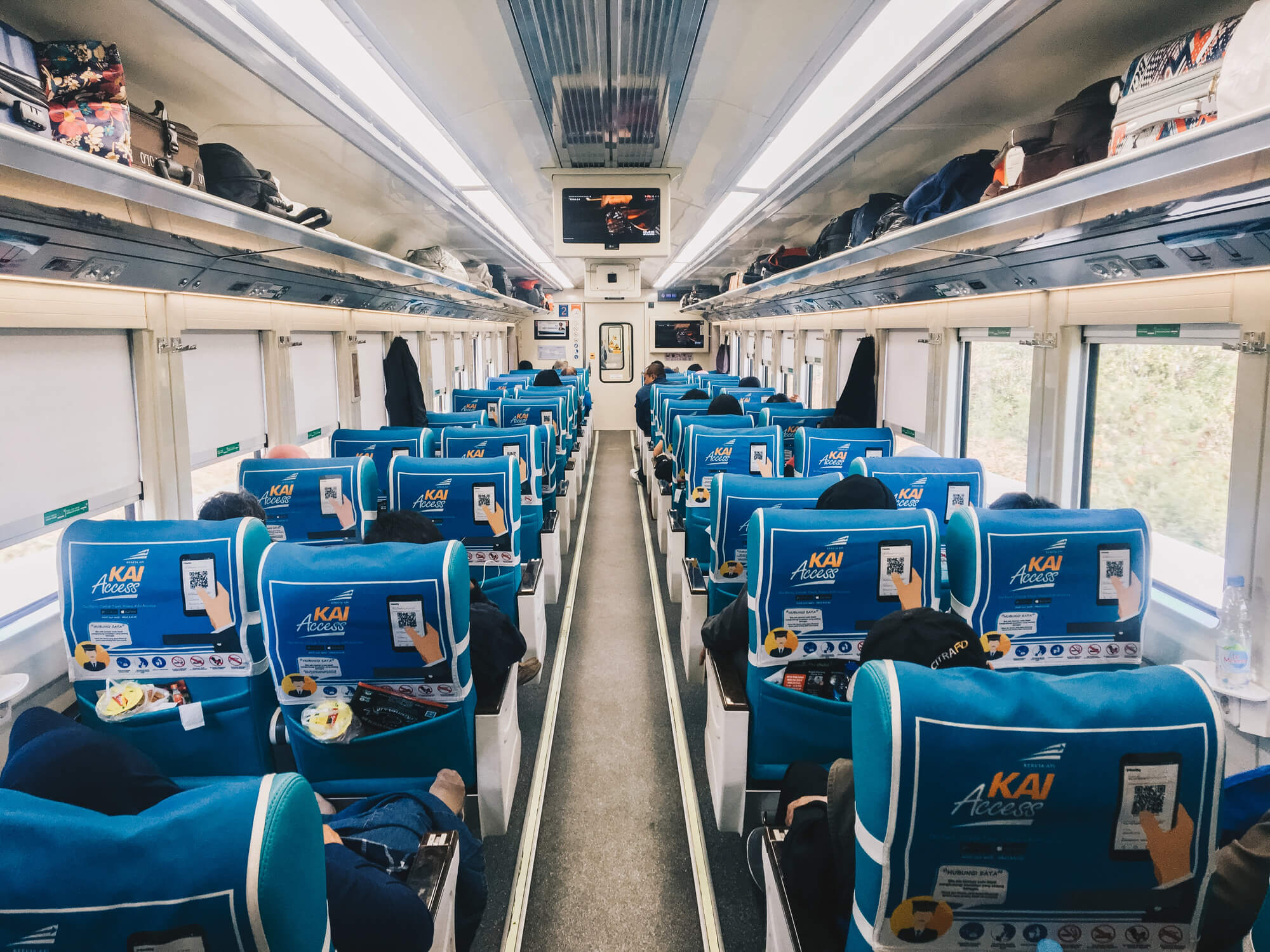
Boarding Procedures for First-Timer
Boarding a train in Indonesia can feel surprisingly structured, more like catching a flight than taking a train in Europe. With steps like security checks and ticket validation, it’s best to allow extra time to navigate the process smoothly. Here’s what to expect:
1. Print Your Boarding Pass (or Use E-Ticket)
In 2025, printing a physical boarding pass (an orange paper card) is often no longer necessary for train travel in Indonesia. If you book your ticket through platforms like KAI Access, Traveloka, or tiket.com, you’ll usually receive an e-ticket with a QR code, which can serve as your boarding pass. Simply show the QR code on your phone at the check-in gate, and you’re good to go.
However, some stations or routes might still require a printed boarding pass. To be safe, it’s always a good idea to arrive at the station with enough time to use the self-service kiosks if needed.
2. Check-In and Identity Verification
Once you have your e-ticket or boarding pass, proceed to the check-in gate. Indonesian train stations offer two main methods for identity verification:
- Manual Identity Check: At smaller stations or those without face recognition, staff will manually verify your identity. Be prepared to show your boarding pass along with your passport to proceed.
- Face Recognition Check-In: At major stations equipped with this technology, you can simply stand in front of the camera at the check-in gate. The system will scan your face and match it with your registered identity. To use this, you’ll need to have completed a one-time registration.
3. Board Your Train
Once you’ve passed the check-in gate, you’ll find another waiting area closer to the platform. This means you don’t need to wait for the train’s arrival before completing the check-in process—you can relax in the designated area until your train is ready to board.
When it’s time to board, keep your boarding pass or ticket handy and ask the station staff if you’re unsure about the direction of your carriage. Trains in Indonesia can be very long, and knowing which way to walk will save you time and hassle, especially if the train has a short stop at your station.
Pay close attention to announcements about your train’s platform and carriage order. These announcements are made in both Indonesian and English, so listen carefully, especially for the name of your train to avoid any confusion. Be aware that electronic screens often don’t work, so relying on the audio announcements is your best bet.
Additional Tips for Best Train Travel Experience
No Standing Tickets in Indonesia
Unlike some countries, Indonesia does not sell standing tickets for trains. If all seats are booked, the train is considered fully booked, and you will need to select another train or change your travel schedule.
Standing tickets are only available on commuter lines and urban trains (MRT/LRT) serving short-distance routes.
Scoring Cheap Tickets
If you book a ticket within two hours of departure, some trains may offer up to a 50% discount. Consider traveling on weekdays instead of weekends for less crowded trains and better promotions. However, if your travel plans depend heavily on your train journey, it’s best to book your tickets well in advance to avoid any risks or disruptions.
Porters at Train Stations
If you’re traveling with children or a lot of luggage, porters at Indonesian train stations can be a great help. You can hire a porter as soon as you arrive at the station, and they’ll assist you with your bags, guide you to your seat, and keep you informed of any changes.
When the train arrives at your destination, porters will be ready to assist you again, helping with your luggage all the way to your car or the station exit. The cost for a porter typically starts at around 20,000 IDR (around 1,3 USD).
Why Choose Train Travel?
Now that you know everything about trains in Indonesia and Java, it’s easy to see why they’re one of the best transportation options for both locals and tourists. While buses, cars, and flights are viable alternatives, trains offer distinct advantages that make them a standout choice for many travelers.
1. Avoiding Traffic Jams
Java’s roads, especially in major cities like Jakarta, Bandung, and Surabaya, are notorious for heavy traffic. Buses and private cars often face unpredictable delays, turning a few-hour journey into an all-day ordeal. Trains, on the other hand, run on dedicated tracks, ensuring a smooth journey without the stress of traffic jams.
2. Punctuality and Reliability
Indonesian trains are known for their reliability, operating on a set schedule with minimal delays. In contrast, buses may run late due to traffic or road conditions, and flights can face cancellations or delays during peak seasons or bad weather. With trains, you can plan your itinerary confidently.
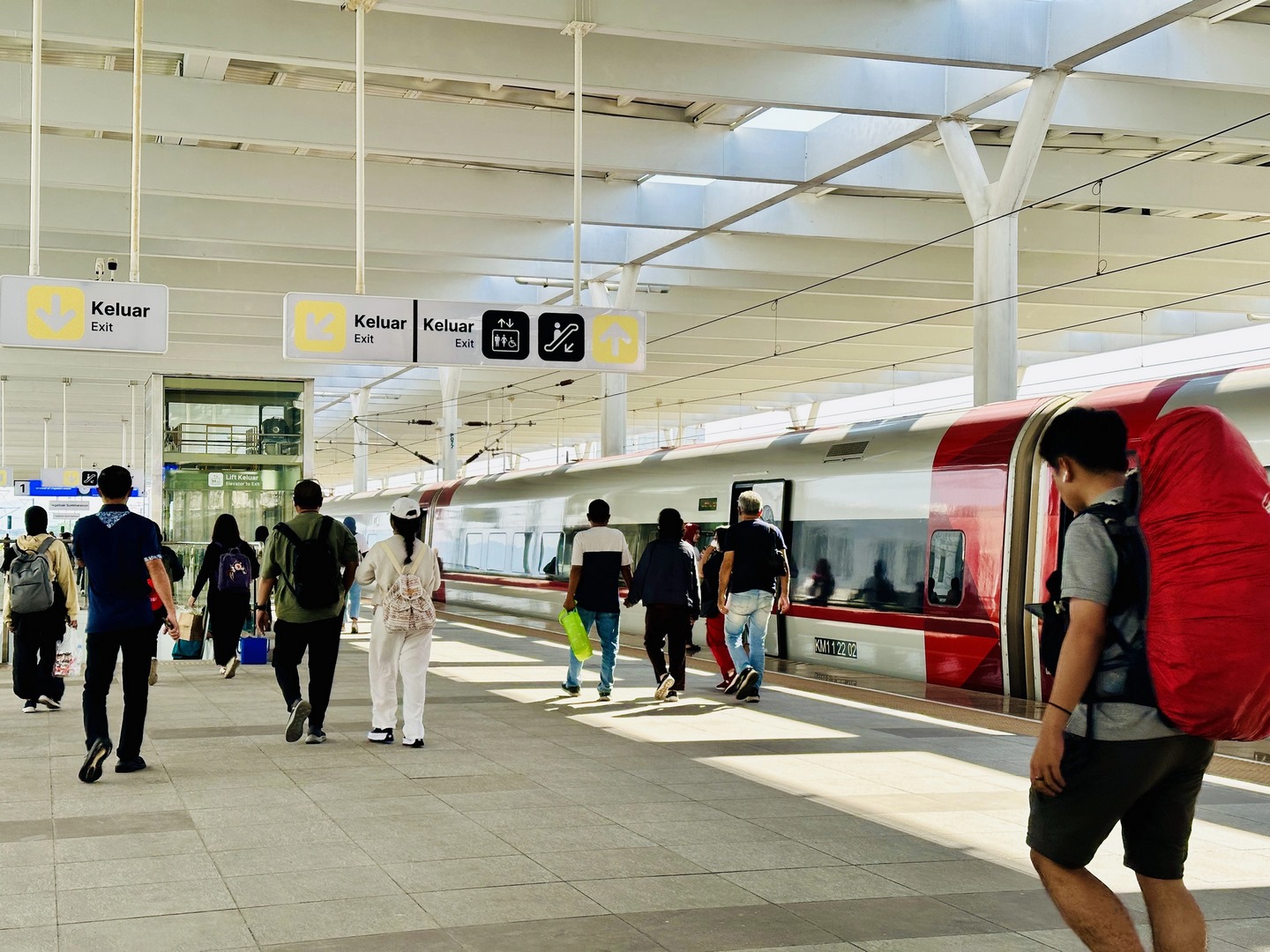
3. Comfort and Facilities
Compared to buses, trains generally provide more comfort, especially for long journeys. With air-conditioned cabins, spacious seating, and onboard facilities such as toilets, trains offer a more pleasant experience than cramped buses navigating Java’s winding roads.
4. Strategic Stations
Train stations are often located in or near city centers, making it easy to access tourist attractions without needing additional long transfers. In comparison, airports are usually far from city centers, requiring extra time and money for transportation. Bus terminals, while closer, may not always be in the most convenient areas for travelers.
5. Scenic Views
One of the biggest perks of train travel is the opportunity to enjoy Java’s stunning landscapes. From lush rice fields and rolling hills to glimpses of volcanoes, trains provide a window to the island’s natural beauty—something you’d miss when flying or taking a bus on highways.
6. Eco-Friendly Option
For environmentally conscious travelers, trains are a greener choice compared to flights or cars. They produce fewer emissions per passenger, making them a more sustainable way to explore the island.
FAQ
How far in advance can I book train tickets?
Tickets can usually be booked up to 30 days in advance. However, before Idul Fitri (the peak holiday season), tickets are available 45 days ahead to accommodate the high demand. For high-speed trains like Whoosh, availability may open earlier depending on the schedule.
Where can I find and book tickets? Are Traveloka and tiket.com reliable?
Traveloka and Tiket.com are trustworthy alternatives for international travelers, with Tiket.com being the only platform offering tickets for the Whoosh train.
What should I do if tickets are sold out?
If tickets are unavailable, try checking other classes, looking for alternative routes, or visiting the station for last-minute availability. Cancellation tickets might also become available closer to departure.
It’s also worth checking if you selected the correct station, as many cities in Indonesia have multiple train stations serving different routes.
Do children need tickets?
Yes, all children need a ticket. Children under 3 years old can travel for free if sharing a seat with an adult. For children aged 3 years and older, a full-priced adult ticket is required. Always include children when booking to ensure proper registration.
